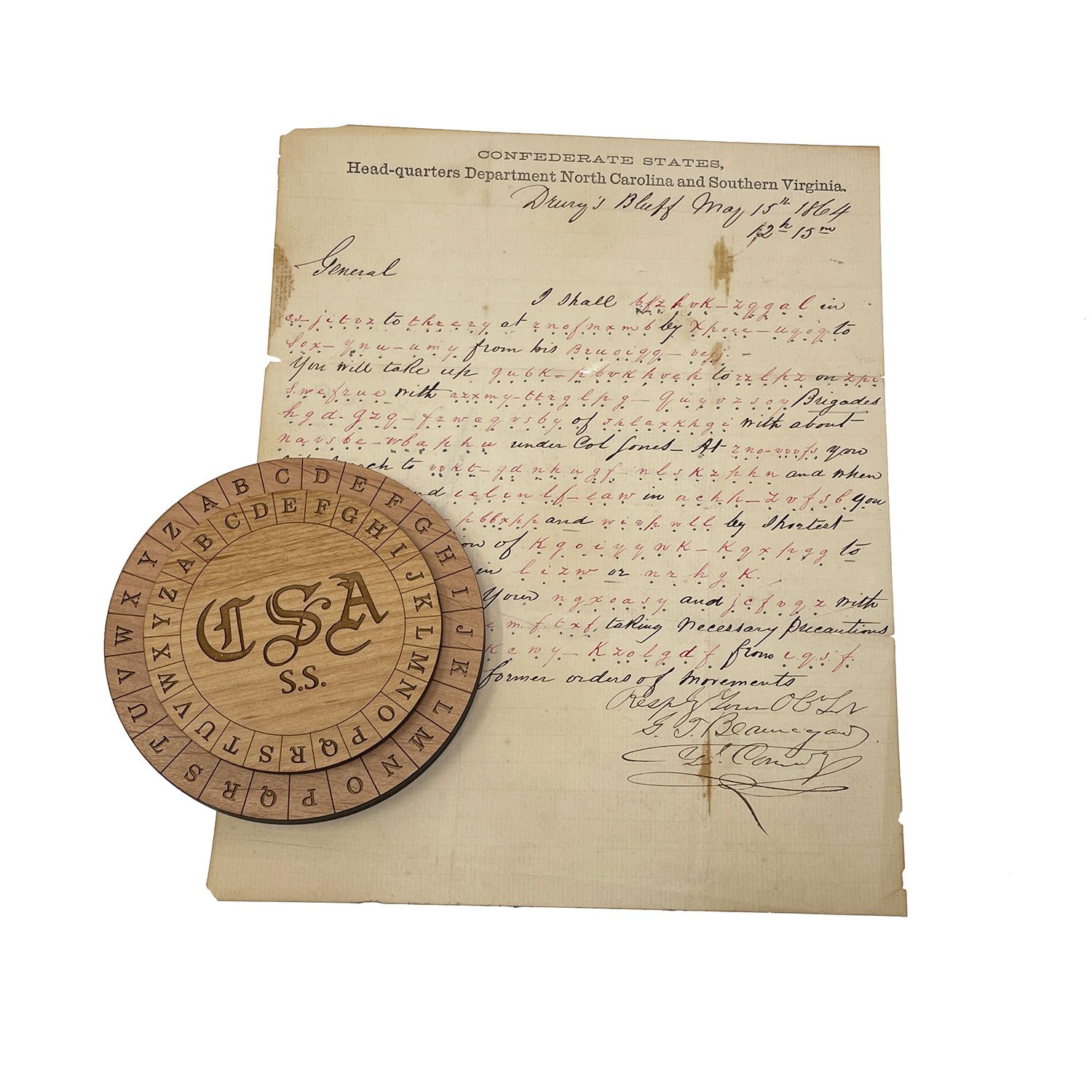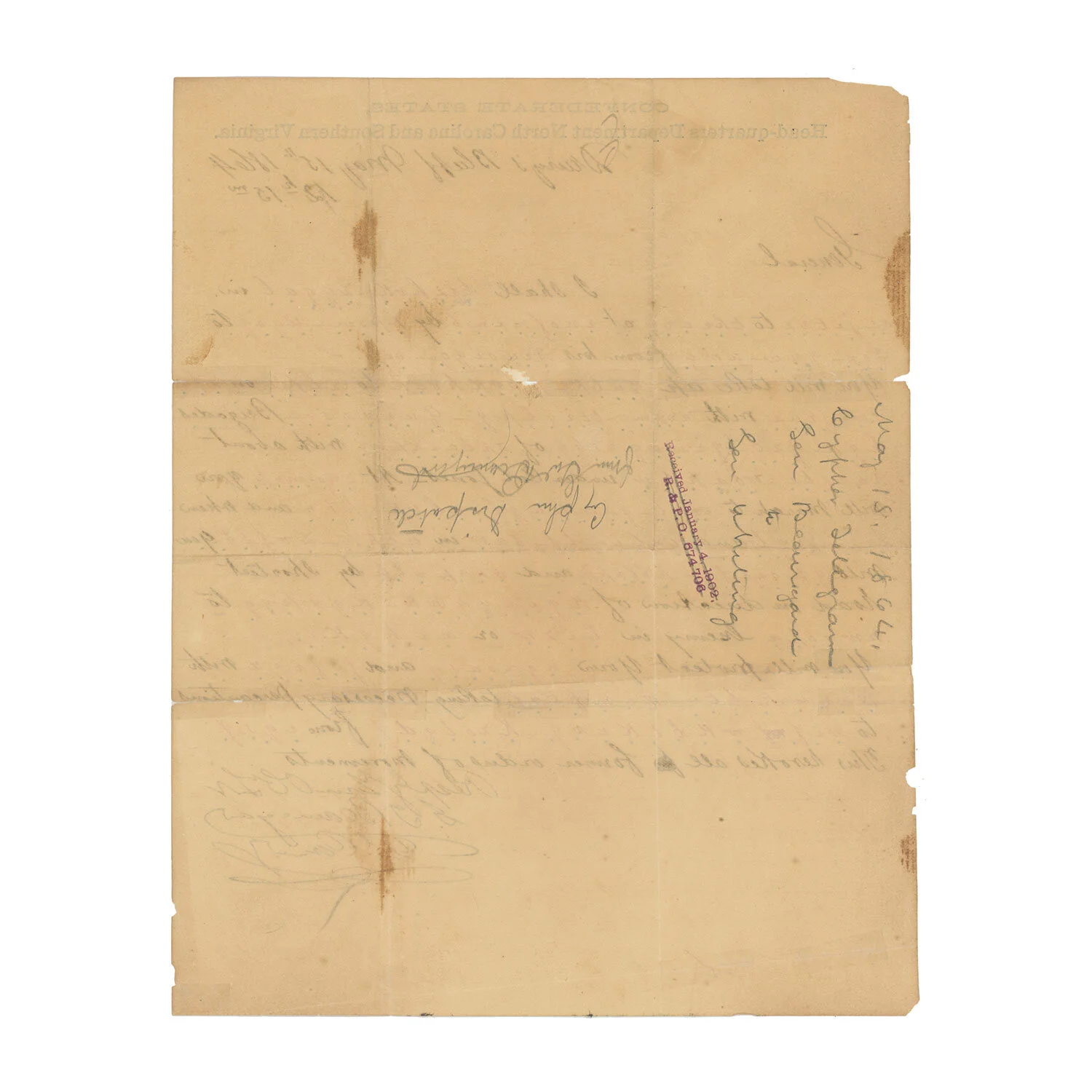Rare Confederate Cipher Message — General P.G.T. Beauregard Signed May 15, 1864 Orders to General William H.C. Whiting to “attack enemy in rear or flank” at Battle of Drewry's Bluff
Rare Confederate Cipher Message — General P.G.T. Beauregard Signed May 15, 1864 Orders to General William H.C. Whiting to “attack enemy in rear or flank” at Battle of Drewry's Bluff
Item No. 7949718
When General P.G.T. Beauregard signed these incredibly rare ciphered orders for attack to Major General William H.C. Whiting on May 15, 1864, he anticipated that the following day would result in a great victory over General Benjamin F. Butler’s federal Army of the James. Instead, the Louisianan would have to accept an empty tactical victory, while Whiting’s career would be ruined.
Beauregard was one of the most famous generals in the Confederate Army, having initiated the attack on Fort Sumter, claimed the victory at First Manassas, and fought Grant at Shiloh. In 1864 he was in command of the Department of North Carolina and Southern Virginia, responsible for the region south of the James River and protecting the vital rail lines linking Richmond and General Robert E. Lee’s army with points south.
In May 1864, with Butler having advanced far ahead of his Bermuda Hundred line, Beauregard planned a coordinated attack from multiple directions. The divisions of Robert Ransom, Robert Hoke, and Alfred Colquitt would pin Butler down in front. Whiting’s division, then, would march widely around Butler’s left flank and attack his rear—breaking up Butler’s route of escape and perhaps bagging the lot. Whiting turned out to be a poor choice for the movement, however. He had served on Beauregard’s staff at Fort Sumter and was Joseph E. Johnston’s chief engineer at First Manassas, but had clashed with Confederate President Jefferson Davis and had drawn the ire of General Lee following the Seven Days Battles. Thus he was reassigned to a command in North Carolina, and then to command of the Petersburg defenses in May 1864.
The orders communicated to Whiting via this ciphered message state that Beauregard will:
…attack enemy in front tomorrow at daybreak” and directs Whiting to “take up your position tonight at Swift Creek with Wise’s, Martin’s, Dearing’s Brigades and two regiments of Colquitt’s Brigade, with about twenty field pieces under Col. Jones. At daybreak you will march to Port Walthall Junction, and when you hear an engagement in your front you will advance boldly and rapidly by shortest road in direction of heaviest firing to attack enemy in rear or flank. You will protect your advance and flanks with Dearing’s cavalry, taking necessary precautions to distinguish friends from foes.
The order is then signed by Beauregard.
The attack was opened in a dense fog on the morning of the 16th. The three divisions making the main advance on Butler had some initial success, but lost their momentum by mid-morning. However, the federal high command was unravelling and their forces were beginning to withdraw back to the safety of Bermuda Hundred. Whiting’s division could still go in for the kill. His 5,000 men had marched east out of Petersburg at 5am and had advanced as far as Port Walthall Junction by 11, but they, too, lost their momentum and the attack stalled out. Butler’s army had escaped.
The battle was technically a Confederate victory, but it was strongly felt that an opportunity had been lost. Whiting received the largest share of the blame. Rumors of drunkenness caught the ear of Jefferson Davis and Whiting was out—he never again held a command in the field.
The Confederate cipher system was based on a 400-year-old system known as the “diplomatic cipher,” in which the letters in a predetermined key word or phrase—in this case the phrase is “FIGHT AND CONQUER”—were paired with the letters in the message. A mechanical two-wheel cipher device would then be used to encode the message further so that it could not be deciphered unless the reader had both the code word and the cipher wheel. This was an effective system, but deciphering the messages was very time consuming and messages were sometimes garbled in transmission.
The wooden cipher tool pictured is a modern reproduction, but functions as the originals and can be used to code/decode this message. It is included with the document.
The complete message appears on one side of a 7 3/4” x 10” piece of stationery pre-printed with Beauregard’s department headquarters header. It is in very good condition with light toning and foxing. Creased at the original folds. The document is briefly docketed on the reverse, where there are also found several well-done tape reinforcements at folds. The full text of the order appears below, with the coded portions underlined. (Note: the full and uncoded text of the order also appears in Beauregard’s official report dated June 10, 1864.
CONFEDERATE STATES,
Head-quarters Department North Carolina and Southern Virginia.
Drewry’s Bluff May 15th 1864
12h 15mGeneral
I shall attack enemy in front to morrow at daybreak by River Road, to cut him off from his Bermuda base. You will take up your position to night at Swift Creek with Wise’s, Martin’s, Dearing’s Brigades, and two regiments of Colquitt’s Brigade, with about twenty field pieces under Col. Jones. At daybreak you will march to Port Walthall Junction, and when you hear an engagement in your front you will advance boldly and rapidly by shortest road in direction of heaviest firing to attack enemy in rear or flank. You will protect your advance and flanks with Dearing’s cavalry, taking necessary precautions to distinguish friends from foes. Please communicate this to General Hill. This revokes all former orders of movements.
Resply Your Ob Sr
G. T. Beauregard
Gen’l Commd’g



